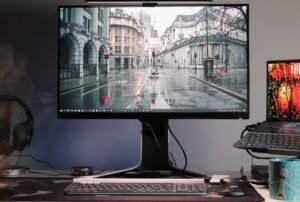GPT vs MBR Disk
The choice between GPT (GUID Partition Table) and MBR (Master Boot Record) disk formats is an important consideration when setting up a storage device or installing an operating system. Both GPT and MBR have their pros and cons, and understanding their differences can help you make an informed decision.
Key Takeaways:
- GPT and MBR are disk partitioning styles with different structures and limitations.
- GPT supports larger disk sizes and a higher number of partitions compared to MBR.
- MBR has better compatibility with older systems and legacy BIOS booting.
**GPT** is a newer disk partitioning style that provides several advantages over MBR. GPT uses a globally unique identifier (GUID) to define partitions and is capable of addressing larger disk sizes and a higher number of partitions than MBR.
On the other hand, **MBR** is the traditional disk partitioning style that has been used for decades. It works well with older systems and is more compatible with legacy BIOS booting. However, MBR has its limitations when it comes to larger disks.
GPT vs MBR: A Comparison
| Feature | GPT | MBR |
|---|---|---|
| Disk Size | Supports up to 9.4 ZB (zettabytes) | Supports up to 2 TB (terabytes) |
| Number of Partitions | Allows up to 128 partitions | Supports up to 4 primary partitions |
| Boot Process | Requires UEFI firmware | Compatible with BIOS and UEFI |
*GPT supports disk sizes up to **9.4 zettabytes**, which is many times larger than the maximum 2 terabyte limit of MBR.
In terms of the number of partitions, GPT allows up to **128 partitions**, while MBR supports **only 4 primary partitions**. This can be a significant factor when dealing with complex storage setups or multi-boot configurations.
*GPT requires a **UEFI firmware** for the boot process. It may not work with older systems that use BIOS. MBR, on the other hand, is compatible with both BIOS and UEFI booting technologies. This makes MBR a more suitable choice for systems with legacy hardware.
Which Disk Format Should You Choose?
The choice between GPT and MBR depends on various factors, including the intended use of the disk, compatibility requirements, and system limitations. Consider the following points:
- If you require a larger disk size or need more than 4 primary partitions, **GPT** is the better choice.
- For better compatibility with older systems or BIOS booting, **MBR** is recommended.
- Consider the limitations and requirements of your specific hardware and software environment.
- Always check the documentation and recommendations provided by the operating system or software you plan to use.
As a user, it’s important to understand the differences between GPT and MBR disk formats and choose the one that suits your needs best.
Conclusion
The decision between GPT and MBR disk formats has a significant impact on disk compatibility, partitioning, and boot processes. By evaluating the specific requirements of your system and considering the benefits and limitations of each format, you can make an informed choice for your storage setup.

Common Misconceptions
Misconception 1: GPT disks are faster than MBR disks
One common misconception is that GPT (GUID Partition Table) disks are faster than MBR (Master Boot Record) disks. However, the type of partition table used does not affect the disk’s performance. The real difference between GPT and MBR lies in their limitations and features.
- GPT and MBR disks have similar read and write speeds.
- The speed of a disk is primarily determined by its hardware and other factors like disk fragmentation, rather than the partition table type.
- GPT disks do offer advantages in terms of scalability, support for larger disk sizes, and more robust error correction capabilities.
Misconception 2: GPT disks can only be used with UEFI systems
Another misconception is that GPT disks can only be used with UEFI (Unified Extensible Firmware Interface) systems, while MBR disks can only be used with legacy BIOS (Basic Input/Output System) systems. This is not entirely accurate.
- GPT disks are fully compatible with both UEFI and BIOS systems.
- UEFI systems are more likely to utilize GPT due to its benefits, such as support for larger disk sizes and more partitions.
- However, modern BIOS systems can also boot from GPT disks, as long as the system has the necessary support for it.
Misconception 3: GPT disks are more secure than MBR disks
There is a misconception that GPT disks provide better security than MBR disks. While GPT does offer certain security features, the partition table type alone does not determine the security of a disk.
- GPT includes a protective MBR, which helps prevent malicious software from modifying the disk’s partition information.
- However, the majority of security measures, such as encryption or access control, are implemented at the file system level and are independent of the partition table type.
- The security of a disk primarily depends on the security measures implemented in the operating system and applications.
Misconception 4: MBR disks are outdated and should not be used anymore
Some people believe that MBR disks are outdated and should not be used anymore due to their limitations. While GPT is the newer and recommended partitioning scheme for modern systems, MBR disks still have their uses and advantages.
- MBR disks are more compatible with older operating systems that do not support GPT, such as Windows XP.
- Some systems may not have UEFI firmware, which may require the use of MBR disks.
- If you have a disk smaller than 2 terabytes and do not need more than four primary partitions, MBR is a viable choice.
Misconception 5: Converting from MBR to GPT is a simple process
Converting a disk from MBR to GPT, or vice versa, is often considered a simple process that can be done easily. However, this is not entirely accurate.
- Converting between partition table types involves potentially destructive operations that can lead to data loss if not done correctly.
- Before converting, it is crucial to backup all data on the disk to ensure its safety.
- Converting from MBR to GPT typically requires reinstalling the operating system, as the process involves changing the disk structure fundamentally.

GPT vs MBR Disk
When it comes to disk partitioning, two main standards are commonly used: GPT (GUID Partition Table) and MBR (Master Boot Record). Each has its own advantages and limitations. In this article, we will explore the differences between GPT and MBR disks in various aspects.
Maximum Partition Size
GPT disks allow for larger partition sizes compared to MBR disks. Whereas MBR disks are limited to a maximum partition size of 2 terabytes, GPT disks can support partitions up to an astonishing 9.4 zettabytes.
| GPT Disk | MBR Disk |
|---|---|
| Largest Partition: 9.4 zettabytes | Largest Partition: 2 terabytes |
Number of Partitions
GPT disks offer a significantly higher number of partitions compared to MBR disks. While MBR disks can have a maximum of four primary partitions or three primary partitions and an extended partition, GPT disks can support up to 128 primary partitions.
| GPT Disk | MBR Disk |
|---|---|
| Maximum Primary Partitions: 128 | Maximum Primary Partitions: 4 (or 3 + 1 extended) |
Compatibility
When it comes to compatibility, MBR disks have an advantage. MBR is supported by a wider range of operating systems, including older systems and some versions of Windows that do not have UEFI support. On the other hand, GPT disks require a UEFI-based system and are not compatible with older systems using BIOS.
| GPT Disk | MBR Disk |
|---|---|
| Requires UEFI-based system | Compatible with BIOS-based systems |
Data Protection
GPT disks provide enhanced data protection compared to MBR disks. GPT disks store a backup partition table at the end of the disk, ensuring redundancy in case the primary partition table becomes corrupted. MBR disks, however, only have a single partition table, making them more susceptible to data loss in case of corruption.
| GPT Disk | MBR Disk |
|---|---|
| Redundant Partition Table | Single Partition Table |
Boot Speed
Booting from GPT disks generally takes longer than booting from MBR disks. This is because GPT disks store boot information in a separate EFI system partition, while MBR disks store boot information in the Master Boot Record itself.
| GPT Disk | MBR Disk |
|---|---|
| Requires separate EFI system partition | Boot information stored in MBR |
Extended Attributes
GPT disks allow for the storage of extended attributes for each file, such as file permissions, access control lists, and checksums. MBR disks do not have built-in support for extended attributes.
| GPT Disk | MBR Disk |
|---|---|
| Supports extended attributes | No support for extended attributes |
Security
GPT disks provide better security features compared to MBR disks. GPT disks support Secure Boot, a mechanism that ensures only trusted software can run during the boot process. MBR disks do not have native support for Secure Boot.
| GPT Disk | MBR Disk |
|---|---|
| Supports Secure Boot | No native support for Secure Boot |
Disk Initializing
Initializing a GPT disk requires initializing the entire disk, erasing any existing data. In contrast, MBR disks can be initialized without erasing data, making it a more convenient option in certain situations.
| GPT Disk | MBR Disk |
|---|---|
| Requires initializing the entire disk | Can be initialized without erasing data |
Partitioning Tools
GPT disks offer more advanced partitioning tools compared to MBR disks. GPT disks support the use of disk spanning, allowing for larger partitions to be created by utilizing space from multiple physical disks.
| GPT Disk | MBR Disk |
|---|---|
| Supports disk spanning | No support for disk spanning |
Conclusion
GPT and MBR disks both have their own strengths and weaknesses. GPT disks offer larger partition sizes, support a higher number of partitions, and provide better data protection and security features. On the other hand, MBR disks offer broader compatibility with older systems and faster booting times. The choice between GPT and MBR ultimately depends on the specific requirements and compatibility needs of the system in question.
Frequently Asked Questions
What is the difference between GPT and MBR?
GPT (GUID Partition Table) and MBR (Master Boot Record) are two different partitioning schemes used on computer storage devices. GPT supports larger disk sizes, allows for more partitions, and provides a more robust partitioning system compared to MBR. MBR, on the other hand, is an older and less capable partitioning scheme primarily used on older systems and devices with smaller disk sizes.
Which disk format should I use, GPT or MBR?
The choice between GPT and MBR largely depends on your system requirements and the specific use case. If you have a modern computer with UEFI firmware, need support for larger disk sizes over 2TB, or want to utilize more than four primary partitions, GPT is generally recommended. If you have an older computer with legacy BIOS, smaller disk sizes, or compatibility needs with older systems, MBR might be more suitable.
Can I convert a disk from GPT to MBR, or vice versa?
Converting a disk from GPT to MBR or vice versa is possible, but it typically involves reformatting the disk and removing all data. It’s crucial to back up your data before attempting any conversion process, as it will result in data loss. Several third-party partitioning tools exist that can help with this conversion process, but caution should be exercised, and professional assistance may be recommended.
Can I install an operating system on a GPT disk?
Yes, most modern operating systems, including Windows, Linux, and macOS, support installation on GPT disks. However, it’s essential to ensure that your system’s firmware (BIOS or UEFI) can handle booting from GPT disks. If your system uses legacy BIOS, you may need to enable the UEFI boot mode or convert the disk to MBR before installing the operating system.
Are there any limitations to using MBR?
Yes, MBR has certain limitations compared to GPT. The most significant limitation is that MBR only supports disk sizes up to 2TB and can have a maximum of four primary partitions. Additionally, MBR relies on a single boot sector, making it more susceptible to corruption or failure. It also does not support modern features such as secure boot or native data redundancy like GPT does.
Do GPT and MBR have any impact on data speed or performance?
The partitioning scheme used (GPT or MBR) generally does not have a significant impact on the speed or performance of the data stored on the disk. Disk speed and performance are primarily influenced by factors such as the disk type (HDD or SSD), its interface (SATA, NVMe), and other system components like CPU, RAM, and disk controller. Nevertheless, it’s crucial to choose an appropriate partitioning scheme that suits your system requirements.
Can I dual-boot multiple operating systems with GPT or MBR?
Yes, both GPT and MBR allow for dual-booting multiple operating systems. However, GPT offers more flexibility due to its support for numerous partitions, while MBR is limited to four primary partitions. If you plan to install multiple operating systems, it’s recommended to use GPT to avoid partitioning limitations and ensure compatibility with modern bootloader software.
What happens if I try to use GPT on an unsupported system?
If you attempt to use a GPT disk on a system with a legacy BIOS that does not support booting from GPT disks, the system may not recognize the disk or fail to boot from it. In such cases, you would need to either enable the UEFI boot mode in the BIOS settings or convert the disk to the MBR partitioning scheme before it can be utilized with the system.
Can I convert a disk from MBR to GPT without losing data?
Converting an MBR disk to GPT without losing data is technically possible, but it is a complicated process and comes with inherent risks. To perform the conversion, you would need to use specialized partitioning software that supports MBR-to-GPT conversion. However, it’s crucial to note that failures during the conversion process can lead to data loss, so backing up your data before attempting such conversions is essential.
Are there any benefits to using MBR over GPT?
While GPT is generally more recommended for modern systems, there are a few specific scenarios where MBR might be preferred. For example, some older operating systems or embedded systems may only support booting from MBR disks. Additionally, disk cloning and certain data recovery processes may be more straightforward on MBR disks due to their simpler partitioning structure. However, these cases are becoming less common as modern systems increasingly adopt GPT as the default choice.




